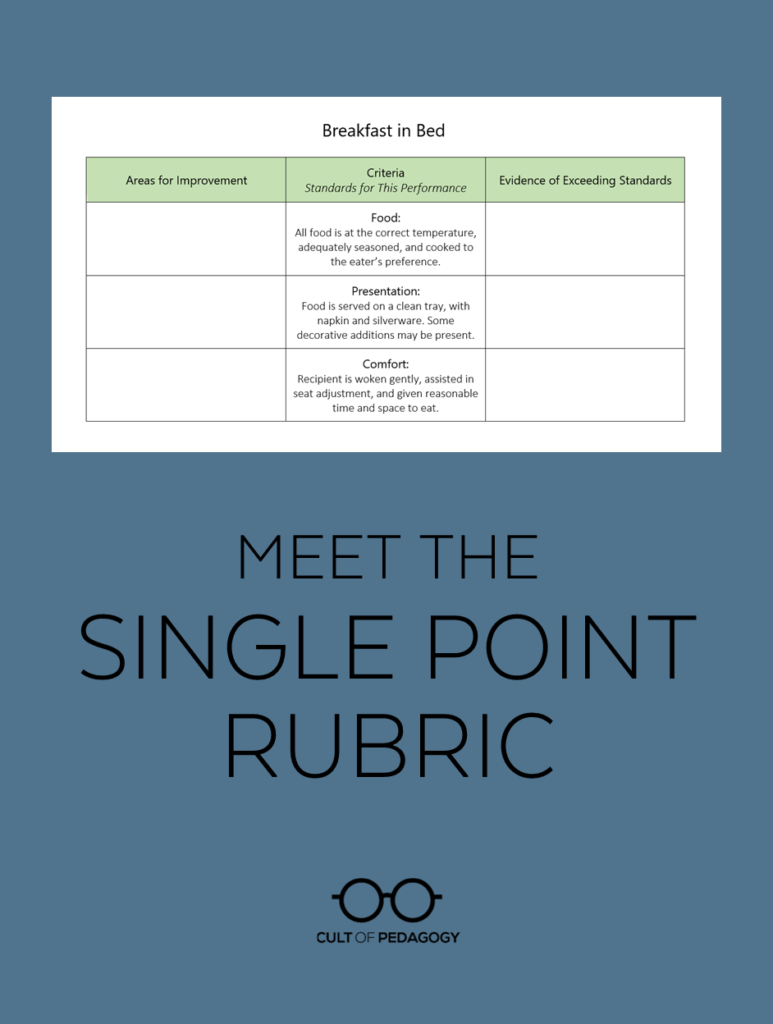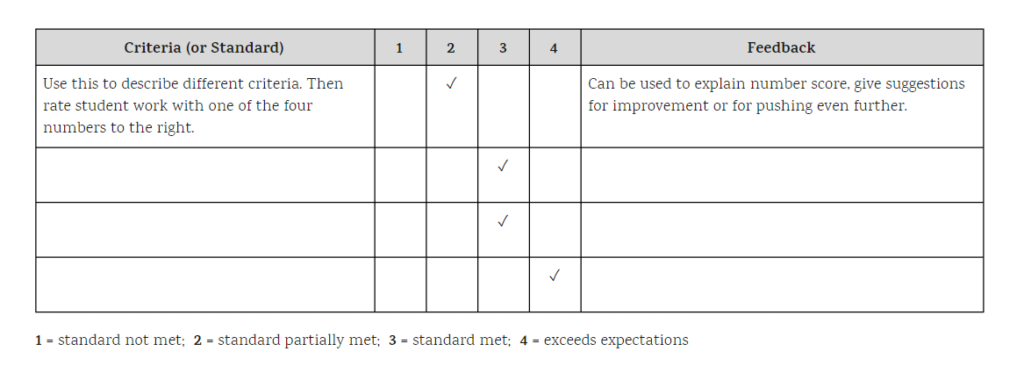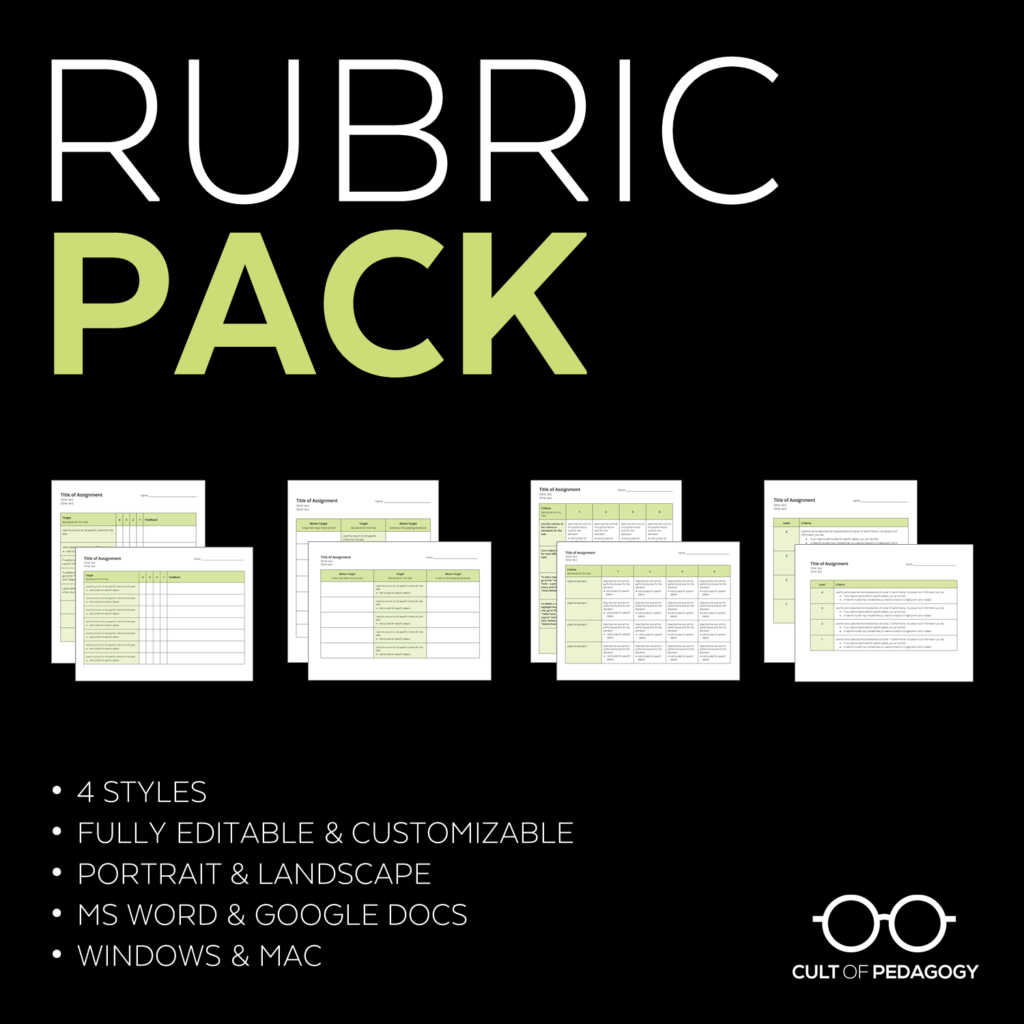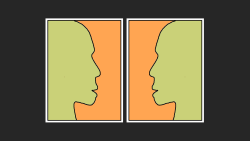
The practice of using single point rubrics is slowly but surely catching on. The simplicity of these rubrics — with just a single column of criteria, rather than a full menu of performance levels — offers a whole host of benefits:
- Teachers find them easier and faster to create, because they no longer have to spend precious time thinking up all the different ways students could fail to meet expectations.
- Students find them easier to read when preparing an assignment. With only the target expectations to focus on, they are more likely to read those expectations.
- They allow for higher-quality feedback, because teachers must specify key problem areas and notable areas of excellence for that particular student, rather than choosing from a list of generic descriptions.
Want to Learn More?
I first talked about this type of rubric in an earlier post (Know Your Terms: Holistic, Analytic, and Single-Point Rubrics). If this is the first time you’ve encountered this type of rubric, reading this will give you some background knowledge on all the different types of rubrics and why the single-point deserves world domination.
To give credit where it’s due, I did not come up with the name single point rubric. Although the idea for a simplified rubric with a single set of criteria came to me independently, when I went looking for academic support for its use, I found that the type of rubric I had in mind was given the name “Single Point Rubric” in 2000 during a conference presentation by someone named Mary Dietz. Attending that conference was a researcher named Jarene Fluckiger, who published a study on its effectiveness in 2010. (The reference to Dietz is in Fluckiger’s paper, but no one named Dietz has published anything on the topic.)
Show Us Your Rubrics!
I urge you to take one of your most convoluted rubrics and make a single-point version of it. Then show it to the world, so other teachers can learn: Take a screenshot of it and post the picture on Twitter with the hashtag #singlepointrubric. If you aren’t on Twitter or don’t feel like doing this, just put a link to your rubric in the comments below. Help us start a movement to rid the world of ineffective rubrics!
Another Variation (Added in 2017)
After considering some of the limitations of this format, I played around with the rubric a bit more and came up with this variation:

The original version of the single point rubric allowed no space for actually pointing out when the student hit the standard, apart from maybe circling or highlighting the middle column. With this format, teachers can pinpoint where the student is on each descriptor, then offer feedback, either constructive, positive, or both.
To grab a copy of this for your own modification, click here.
Need Ready-Made Rubrics?
My Rubric Pack gives you four different designs in Microsoft Word and Google Docs formats. It also comes with video tutorials to show you how to customize them for any need, plus a Teacher’s Manual to help you understand the pros and cons of each style. Check it out here:
Join my mailing list and never miss another post. You’ll get weekly tips, tools, and inspiration — in quick, bite-sized packages — all geared toward making your teaching more effective and joyful. To thank you, I’ll send you a free copy of my new e-booklet, 20 Ways to Cut Your Grading Time in Half. I look forward to getting to know you better!






Hi Jennifer,
I am new to your website and I am loving it! Thank you for posting this article. The idea of a single point rubrics is revolutionary and new to me; just reading about it makes me feel like a weight has been lifted off my shoulders. I have often wondered how much my second graders are really absorbing when we go over the rubrics I provide them with. Despite my best attempts to make them child friendly they seem wordy and overwhelming. I have also often questioned why I provide students with ‘markers for failure’ instead of wholly focusing their attention on what I want them to strive for and attain. I love the open-ended areas provided to comment on areas of concern and areas where a child has excelled. Using regular rubrics, I find that often I am trying to jam in comments regarding a student’s’ performance that are not outlined in my rigid prescribed rubrics; the single point rubrics provides me with open-ended areas to comment on these clearly and without limiting by thoughts to items only described in the rubrics. The single point rubrics is definitely a tool that I will be implementing in my classroom. Thank you again!
Michelle
Hi Michelle!
You know what? I forgot all about jamming comments into the fuller rubrics. I did the exact same thing. Ridiculous! That’s such a huge sign of the rubric language being insufficient for giving feedback. Why have it there in the first place if we feel the need to explain anyway? I’m so glad you like this idea. I would love to see a copy of your first attempt!
All rubrics are hard to use. They force you to view student work in a narrow way that does not provide a holistic look at the student’s work or attitude. I agree that rubric language is insufficient for giving feedback. When I was using rubrics at the college level, which I had to do, I included a section to write comments, which allowed me to go beyond the narrow, insufficient language of the rubric.
This saves valuable time!! We were using words like–exceeds expectations, almost exceeds expectations, meets, expectations, somewhat meets expectations, does not meet expectations. Fully meets standard, somewhat meets standard, dos not meet standard….and as you can tell, it was 1 simple word that changed the score. Teachers would meet to discuss if a child “met” expectations, or if they “somewhat” met expectations–and as you can imagine there are so many things more important to do. This is easier to create and to grade with. I’m excited to have them peer edit with it.
Please send me any feedback!! I was thinking of a score of 0 for concerns, 1 for the middle column, and a 2 for the thrid column, the exemplars. But if a 0 is too harsh, I can start with a 1, then go to 2 & 3 instead. Thoughts??
The Flat Earth movement is also slowly catching on, but it doesn’t make it right 😉
They’re an interesting tool worth exploring but I would be hesitant to use for all areas of learning. I think they benefit teachers more than they do students, and this may only be a short-term gain. I don’t think they benefit novice learners at all.
By having only the one descriptor, it’s not providing all students with an ‘entry-point’ to be able to achieve the standard. This might result in students needing to seek help from a teacher so they can get started, or the teacher having to provide more feedback for novice learners as to why they didn’t reach the standard and what they need to do next in order to move towards it. Why not just include the smaller steps in the rubric, then? If the argument is that the students don’t read them, it’s not really a strong argument.
Using the SOLO Taxonomy structure as a rubric, for example, gives the students an entry point (first complete one aspect of the task, them many, then make connections, etc). A one-point rubric is an equivalent of only presenting the third column of the SOLO and ‘hiding’ the first two and the fourth columns. I’m not sure that benefits students to become assessment-capable or self-directed learners.
(Didn’t mean to sound sarcastic with the flat Earth comparison there!)
Having said that, a one point rubric could encourage students to co-construct success criteria. I’ve probably been a bit too hasty with my first response.
Michael,
As much as I love Jennifer Gonzalez, I have to agree with you on this one. As a former Middle/High English teacher, I can see how this is a well-structured peer- and self-editing sheet; however, a rubric it is not. The power of the rubric is in seeing the possibilities at each level for multiple criteria. I agree that this is more for the teacher than the student.
Maybe we need to restructure the rubric, so it incorporates student feedback as well as teacher feedback, or perhaps this one-point rubric should be used to assess each point in the rubric with the student filling in the level s/he is shooting for. As some teachers are seeing a value in it, how can we use it without losing the power of a traditional rubric?
Eileen
I like the idea of a single point rubric for two reasons. First, it communicates the goals. Second, it doesn’t fall into the traps when grading on a multipoint rubric. A multipoint rubric can be too specific, where a student can do some excellent work but maybe it’s not on the rubric, or a student misses something on a rubric but in the big picture the thing that is missing is inconsequential. If you make your multipoint rubric not specific to avoid the pitfalls mentioned above, then the rubric no longer does what it’s meant to, which is to remove objectivity.
I don’t like the idea of writing feedback on each line of a single point rubric. Waaaay too much time for not enough gain. Feedback is only useful when the person receiving the feedback had to do something with it. I would suggest being picky and only leave written feedback on one or two lines.
I mostly use a rubric like the 2017 Version.
The best IMO is to begin with showing the students an exemplar, and then have them rate themselves first. They can also do a short compare/contrast between their work and the exemplar. Then you give them your rating.
The way you seem to have constructed the one point rubric does provide the teacher with a way to critique how close to the expectations the student has come. I think it is most useful for multi-part, large assignments to ensure students are on the right track. The teacher needs to fill in where improvement is needed and where the student has more than met the expectations/criteria of the assignment.
The question for me is how you would grade an assignment using a one-point rubric? How would you do it? Is it important that the student have a grade? Does a student need to know how close to the criteria they have come?
What would a final rubric with a one-point scale look like?
I sort of see both sides here, and we are adopting this cautiously. For us, this is a great tool for formative assessments. It’s great for students, peer feedback, and a quick way to give students an idea of what they need to do next, without assigning a number level. For summatives, it’s not specific enough. I am a firm believer in descriptors and task specific clarification. Otherwise it is too difficult for students and teachers to choose and justify a level. I really don’t like the last variation, as it seems like the worst of both worlds… the numbers seem to come out of nowhere. Still love you though, Jennifer Gonzalez!
Hi Michael, would you have a link to the SOLO taxonomy you are speaking of?
Hi Lisa,
Check out the post, Is That Higher-Order Task Really Higher Order? Just scroll down to the section, Defining Our Terms, and you’ll find a link to the SOLO Taxonomy. Hope that helps!
Hello,
I just bought your rubric pack from TPT. I downloaded it and it is saying file cannot be opened. I would like to have the materials for this pack so I can start making some rubrics. I can show you my receipt as well.
D’Asia, we received your email about this. When you have a chance, check your inbox for a reply from last Saturday. If you don’t see it there, you may want to check your spam folder. If you don’t see a reply there either, just let us know at support@cultofpedagogy.com and we’ll be happy to resend it.
How do you grade it?
Thanks for the question!
I think this kind of rubric works best for ongoing assessment, for assignments where students have the opportunity to re-submit with improvements. If you needed to justify a point score, though, you could add a range of points to each column. So for a 100 point assignment, the top of the center column could say something like “85-94 points,” the left could say “0-84 points,” and the right could say “95-105 points” or something in those ranges. I would probably add an extra row right underneath the top row that contained those ranges.
Then when you grade an assignment, if you end up writing a whole lot of comments in that left column, then the score would be lower in that 0-84 range, whereas if there was just one minor comment, it would be about an 83 or 84. Similarly, if there’s a lot in the right-hand column, the score would be at or slightly above 100. The goal would be to get every student to 84 or above — within target range or better — and so in the best of cases, the student would use the “needs improvement” feedback to actually make improvements. Does that sound like it would work?
Hello,
I was wondering if you had a sample with the range of points added to it? Also, with the addition of the range of points what are your thoughts on using it as a summative assessment?
Hello Karen,
If you scroll to the bottom of Know Your Terms: Holistic, Analytic and Single-Point Rubrics, you’ll see a link to Template 1, which shows the point ranges Jenn mentions at the bottom talk about at the bottom. You also might look at Template 2 or the post, How to Turn Rubric Scores into Grades. Whether you use the single point rubric as a formative or summative assessment, I think it’s important to keep in mind that the main benefit it gives students is the opportunity to improve their work based on feedback. So that’s how we would recommend that it be used. Thanks!
Agreed!
Since grades should reflect mastery of an objective, if a student meets all the criteria that was laid out in the center column I think I would have a difficult time giving a student less than a 100 for it. If he/she truly mastered the criteria, wouldn’t that be to 100%? I understand the purpose of the rubric is to give the opportunity for feedback for what wasn’t proficient vs what was above and beyond, but I feel like if we have (and share) a clear idea on what the student will be able to do to show the objective was met, that should qualify as 100% mastery.
(I say this all while of the opinion that traditional grades are, unfortunately, still a necessary evil.)
Hi Gail,
You’re not alone on this. In the post, How to Turn Your Rubric Scores into Grades, you’ll see how you could use points with a single-point rubric, so that a student could get a score of 100% if all criteria in the middle column are met. Hope this helps!
I developed this ‘anti-rubric’ for many of the same reasons you share here. I wrote a blog post about it as well. It’s more of a checklist, but the columns are there for feedback, and also for fixing anything that needs fixing, by whom, by when, etc, to be used mainly for accountability in group projects.
It is meant to be used electronically in google environments, so all you need to do is make a copy for yourself and adapt it.
http://acoecore.org/2015/01/30/how-to-ensure-quality-pbl-products/
and below a link to the actual tool.
https://docs.google.com/a/acoe.org/document/d/1YCFs6zv1SyJX5saHalj0N73xp_wC3S4KmtzDvwVUz6Y/edit
Great contribution. Thanks for the share!
Francisco, Thank you for sharing! So helpful.
I saw a mention of your single point rubric via Twitter and edcampKY. I think this might be a game changer for me. I’ve been working on how to provide better feedback to AP students on writing FRQs and DBQs. Using your template I think I’ve got a rubric I can work with in the fall.
Fantastic! I would love to see it. Some people have actually posted pictures of theirs on Twitter with the #singlepointrubric hashtag. If you were so inclined, it would be wonderful. I think the more often people see examples, the better they can imagine doing the same for themselves. Thanks for letting me know!
Thanks!
Hi,
I’m a teacher and App developer. I’ve developed an Android app called Rubric Scorer, https://play.google.com/store/apps/details?id=com.apps.ips.rubricscorer. I really liked readying about single point rubrics and was wondering if there were any online scoring programs to support single point rubrics. I was thinking I may develop an Android App for scoring and giving feedback for single point rubrics, but thought I’d see what the interest would be in this. Thanks.
Glen, I think many teachers would love that. Could it just be added as an option to the existing app?
Hello all.
I (and many of my fellow teachers) have been eagerly using the single-point-rubric in our classrooms. It has improved the communication with students about their progress. As our district looks ahead to standards based assessment (non number/letter grading), we have been doing a lot of research around methods to evaluate student learning. Using this sort of tool, allows for a more substantial understanding of how students are progressing with the standards and their goals. Attaching a number/letter grade to this type of assessment seems to miss the point. It is a tool I use to show growth and achievement of goals.
One evolution to consider for the single-point rubric is to not have the advanced/exceeding column. The idea comes via Rick Wormeli. I learned from his work that once a student “masters” a standard (the center point/column in the rubric), they should move on to another standard or a more complex variation of the same standard. The right column could therefore be the teacher’s or student’s reflection on how they met the standard or their next steps and possible goals. Being “advanced” or “excelling” at a standard is just an unnecessary evaluation; the student met the standard, that should be good enough.
If anyone is considering a move toward standards based assessment, you should read “On Your Mark: Challenging the Conventions of Grading and Reporting” by Thomas R. Guskey. He uses data and analysis to discuss how grades (numbers, letters and even rubrics) are subjective and even harmful. It is an amazing, eye-opening book. Also, check out the “Cult of Pedagogy” podcast episode 13.
I would love to hear other’s experiences and thoughts. Thank you Jennifer for this great site.
Nate, thank you for this insight. The idea of removing an “exceeds standards” category is kind of revolutionary, but I get it. Do you have any models or samples you might share of what it looks like when a student moves on to a more complex variation of the same standard? Is there any documentation that accompanies that progression…? Some sort of goal-setting or description of how the student plans to push past the standard? Is it discussed between student and teacher? I would like more information on the nuts and bolts of this variation.
This is really interesting, thank you for sharing ideas. At first, I was thinking that instead of say using a “column 3” for a rubric for midpoint that I would use “exceeds” as the criteria. (setting high expectations tends to allow students to rise to the occasion IMO) However, after reading responses, I had the idea that maybe sticking with the mid-range critera, but expressing to students that we’re never really “done.” Explain to students that there will always be feedback and always be room for improvement or taking the learning one step further. Be sure to specifically praise criteria that has been done well, but including next steps (as others have mentioned) in feedback for everyone. Feedback would include suggestions for those that may not have met criteria, and “exceeds” criteria could be used as suggestions for extensions for those that need it. I feel like this could eliminate the “it’s good enough”. Furthermore, in this manner you are differentiating for each student, but no one is really ever done…until the final due date. It certainly would look different depending on the subject, but I think true extensions of work for higher level thinkers is often overlooked and this could be a way to incorporate it without falling into the adding additional work trap. I welcome everyone’s thoughts on this 🙂
Happy Thanksgiving! Jennifer, I just wanted to start out by saying I am in love with your podcast! I have always struggled with retaining anything that is solely presented auditorily, but I am so intrigued by your content that I find myself absorbing everything!!!
Ok…back to the topic. So I’m reading about the exceeds column and possibly just not including it and it made me wonder about the possibility of putting the vertically aligned standard for the next grade level. What do you think?
Hi Heather,
If kids are performing in some areas beyond expectations, I’m not exactly sure why you wouldn’t provide that feedback. If you haven’t aleady, I suggest checking out Know Your Terms: Holistic, Analytic, and Single-Point Rubrics. There’s a section that describes the advantages of leaving the “exceeds” column open-ended — mainly you just don’t want to limit the way in which kids can stretch themselves. Keep in mind that there are a lot of ways kids can exceed expectations without needing to get to the next grade level standard. Hope this helps!
Nate,
Thank you for your comments about the exceeds category. I have also contemplated this part of my rubrics. What I like about this category is that students are reinforced for the exemplary skills they are using. They may not meet the exemplary status on all skills within a writing assignment. However, I think there is power in reinforcing the positive skills that writers are using. Having a column for that is necessary. Since the standards progress from grade level to grade level, would you have an entirely different middle category for some students? I’m also interesting in seeing how this would look. Have you found any examples?
I’ve been using single-point rubrics with my adult ESL learners for a while now and polishing them a bit. I love them and my students love them. I used to work for a school that used extremely dense rubrics–at advanced levels they might have 6 or 7 areas of assessment and 5 grade levels. With 30 boxes, to look at students’ eyes went straight to the final grade. I also had some very clever students who would add up points to figure out how to do the minimum to get an acceptable grade. For example, they’d see that they could miss the length requirement by quite a bit and do a 2 sentence conclusion, as long as they had perfect spelling and grammar. Now my rubrics don’t tell them how to squeak by.
I did put a few templates, including some sample rubrics for essays aligned to the CEFR standards for ESL, up at my Teachers Pay Teachers Store: https://www.teacherspayteachers.com/Product/Single-Point-Rubric-Grading-Bundle-2243910 I don’t know if I’ve done anything overly revolutionary with it except added directions so students know exactly how the system works.
People did ask about how to grade with it and I like your solution of a range. What I like to do is assign points to each area of assessment and tell students that they get 80% of the points if they meet the standard. That leaves me room to reward advanced students and take points off for students who need more work. It’s not a perfect system, but students seem to like it.
How cool! I’m excited to see you have really run with this idea and that it’s working well for you. I never thought about students trying to “game the system” by looking at where they can slack on a rubric, but it’s an excellent point. Thanks for sharing, Walton.
Hi everyone. Debbie suggested I add my version of a single point rubric here. I got to help some new psychology teachers at a career academy design a way to provide feedback to students on their research projects. These were big. semester long projects, and this feedback form worked well I think. Thanks for the single point rubric idea! https://docs.google.com/document/d/1NSdWARGAiP2it1Eb6toIrM65s6dpvq4NQW8bq45VKZo/edit?usp=sharing
Has anyone found an efficient way to fill out a single-point rubric online and return it to students?
Marlene, the best way I can think of would be through Google Classroom; it allows teachers to create a single document, then distribute copies to the whole class at once. When that’s set up, you can then go into every student’s individual file and enter your feedback into their rubric.
This is a great idea! Thank you!!! I’m teaching at the college level, and created a rubric to evaluate my students’ presentations. I can already see that it will work much better as single-point. Simpler for me AND students will get more specific, detailed feedback. Hooray!
I like, however, to give mine a WOW category: show them ways to go over-and-above the requirements (mine almost always says “Use humor” as at least one of the choices) so I might add that at the bottom…..
Hi,
I had never heard of a single-point rubric until I read your article. I’m trying it for my French AP class. Students do many short (5 minute) presentations in target language. I include my attempt at a single-point rubric here in French with English translation on the back (I have it as a Google slide – two in a row in French then two in English for the printout). Comments welcome! I just need to assign points…
https://docs.google.com/presentation/d/1S35H1jtLMZbuEiME0Gy46HQ7sfEcvkNT2ADwukWfc0Y/edit?usp=sharing
I’m an English teacher in an independent high school. I’ve been using a much more basic version of this rubric for years– I’ve always hated the grid! But I like your columns for “concerns” and “advanced,” plus the opportunity to be clear about whether students actually met the standard. Below is my hybrid, which I’m going to use in a two-draft assignment in which the first draft is an in-class diagnostic essay and the second draft is a take-home revision of that essay.
an example of the old version: https://docs.google.com/document/d/106M0BC5UDq4CHLSUgo5rRKF4J8RkW8JtyTGJj-9Ycfw/edit?usp=sharing
new version:
https://docs.google.com/document/d/1v-epAcAQT4ypUP3siswVOUtAF_U1sf3-WDZWL1hXNOs/edit?usp=sharing
Thank you so much for these ideas! I’ve been using the single point rubric since I found it last spring. One of the things I loved about the single point rubric was the visual of being below, at or above standard. I love your variation because it does address some of the limits of the original SPR, but I missed the visual of being above or below. So I adapted a version with the criteria descriptors being in between the 1, 2 and 3, 4 with room for feedback! I’m excited to use it!
Here’s the link: https://docs.google.com/document/d/1nMR9ghojUgk0wqmZg5v0XJySa9SSkxaYNfe3_KEltz0/edit
I like your variation – I had the same thought on the revised version shared here, as it makes sense to do it that way but it didn’t quite have the ‘beauty’ of the original!
I just saw the version you made and love how you incorporated the different symbols onto it and the wording too. Thank you for sharing
I’ve been using something similar for years but didn’t know it was a “thing”. I really hate wordy rubrics or scales from 1-10. Leaves too much room for interpretation. I find the more basic and black and white approach works well with my jr. high kids. Even with a much less wordy rubric, I have to point out that they need to READ it when it is returned to them.
Love it! I read your original post and have been talking about it whenever a conversation on rubrics comes up!
I love the original, I circle the middle column of fully achieved, if achieved but with slight concerns I can underline the parts that require more work and add into the improvements box. I understand the attempt to improve and if it works better for you then that’s great, but I’ll stick with your original for now, I am still very much in love with it!
Thank you for the excellent blog!
Regards
Lee
Hi thanks for getting me to think about rubric. They are something that I am still getting my head around as my experience with them has so far not been that purposeful. I teach in KG so this year my mission is to make them purposeful for the children and engaging. Any ideas please share fellow teachers!
Brilliant! Really, I can’t believe I’ve never heard of this until now. It solves so much of what I hated about creating rubrics. Thanks for such a clear explanation of it. World domination indeed!! 😀
For the ultimate simple version of the single point rubric, I share with you my desperate attempt to catch up near the end of the term a couple years ago. This is now my regular system: the sticky note rubric.
When I give an assignment, what I’m looking for regarding tasks/standards is on the document, and I reinforce it verbally. Most of our work (I teach journalism) is done through Google Classroom – or digitally in some form. To grade I grab a sticky note, and down the center of it – in tiny writing – I pencil in the 4 or 5 tasks/standards I’m assessing, leaving a margin on the left, concerns, 1 or 2, and a margin on the right, met/exceeded, 3 or 4. I use this as a guide as I read over each assignment, noting the concerns and where the student did well. Since it’s a Google doc, I use the commenting function to note what needs improving and how, as well as what was done well. Sometimes I’ll leave a final comment at the bottom to wrap up the assessment. Then, in Infinite Campus, our online grading system, I use the comments section to briefly (tweet sized) comment what worked and didn’t. On another sticky note (or something more solid) I have a breakdown of where a 16 point assignment (4 tasks/standards) splits into A, B, etc. and where a 20-point assignment splits into A, B, etc. I use my gut to decide whether it’s an 82 or an 88. Writing is highly subjective, after all.
It’s not perfect, but it’s faster and more efficient than anything else I’ve ever tried. I don’t have to use up paper to return a rubric they don’t read, I don’t have to figure out how to add a table to their documents in Google. The comments are on their document if they will read them, and a briefer version is in the online gradebook for them and/or their parents to justify the number I attached to the assignment.
I did go gradeless a couple years ago under a different principal. It was an interesting experiment, providing tons of feedback, but no grade until term, teaching the students to reflect and assess their own work. Many liked it. But it was a lot of work, and when we got a new principal the following year, I just decided it was easier to fall in with the rest of my district. I still provide tons of feedback and truly try to help students improve their writing and thinking. Hope this helps someone.
I really love the theory behind the single point rubric and agree that anything we can do to make expectations clearer to students is worth doing. I’ve tried this in the past, just giving proficiency descriptions, and find that it’s really hard to be consistent with feedback across multiple teachers. The below/developing/exceeds categories need descriptions in order to get good inter-rater reliability.
What I’ve found to be even more effective is to use single-criteria rubrics. Instead of limiting the descriptions to one per criteria, I only assign one criteria per feedback cycle. This way my students can focus on one part of the assignment. If I have a bigger assignment or project that encompasses multiple skills, I break it into smaller parts.
Hi
This is late in the conversation as I looked at the 2015 single rubric and the 2017 modified: to me it now looks again like a four point rubric (with the added one to 4 ratings).
What am I missing? Granted this was a quick read launched from a friends twitter posting.
Hi Mariette! I can see how this variation feels a bit like an analytic rubric. The main difference is that teachers still don’t have to spend time creating descriptors for each performance level — the students still focus on the description of just the targeted expection. This format includes the benefit of letting kids know where they are using a rating toward each standard, while specific teacher feedback supports that rating. Hope that helps!
I have been using Doctopus and Goobric to assess writing. Has anyone tried to incorporate the 2017 rubric into the Goobric format?
Hello! I’m an elementary school teacher in Korea who is very lucky to have introduced to this single point rubrics! I think the rubric template you suggested is quite revolutionary, and I really want to introduce your idea to my colleagues and teachers in Korea. Do you mind if I translate your rubric sample in Korean and post it on my blog? I will never forget to link your website!
Jennifer
I need to let you know that your blog is the best and most complete in advice, resources, up to date with new trends, technology use, etc etc
I have two important tasks to accomplish during my daily morning:
Drink my coffee & read your new publications.
Congratulations
Do you also offer advice to Montessori teachers?
Norma D.
Well, this is fun for us to hear, Norma – thanks for sharing! There is a Montessori post on the site, but if there’s something specific you’re looking for, please let us know. If you want, you can also contact Customer Support and we’ll be happy to help.
What a timely post! I recently finished a narrative writing rubric and had even passed it out to the class to look over.
Convoluted is a great word to describe the rubric I created, and overwhelmed would probably best describe how the students seemed after taking a look.
…I am going to start re-working it now, and I’ll share on Twitter. I’m going to ask their opinion between the two, as well… I think that will be an interesting discussion!
Thank you!
-Stephanie
Yay! Excited to hear this, Stephanie!
Hi all,
I’ve been demoing the Google Classroom rubric beta in my classes. I’ve been converting my old paper 4 point spreadsheet rubrics in to Google Classroom rubrics, which I can then re-use. I’m excited by it because I don’t need to deal with the hassle of using Doctopus, Goobric, Orange Slice, etc; I want it to be a simple and stream-lined as possible for me.
With that said, a 1 point rubric seems great for feedback but harder for grading using Google Classroom rubrics. I converted a KQED Learn Above the Noise Discussion Rubric (linked in the website) into a Google Classroom rubric, and it just felt awkward to grade electronically. Has anyone else tried 1 point rubrics in Google Classroom rubrics?
Hi Scott,
I’ve not actually worked with Google Classroom rubrics, but check out How To Turn Rubric Scores into Grades. Hope this helps!
Jen, thanks for all of the thought-provoking posts. Keep up the good work! It keeps us all thinking of ways to improve our practices. I really like this kind of rubric. I don’t know if I am doing them totally according to the “single point” plan, but here’s my modification: I use the 5 C’s as a basis for all of my rubrics. The Critical Thinking category usually has something to do with the content target of my assignment. What am I really asking them to show me they know? Sometimes I have more than 1 criteria in this category if the project is especially rich. Creativity usually has something to do with applying their knowledge in some kind of novel way, or a presentation that shows them “being the expert” in the content area. Communication is where I look for the quality of good grammar/mechanics. Character or Citizenship may have something to do with citing sources. Collaboration may be an opportunity for partners to give feedback. I don’t always use every C for each rubric, but it’s a nice way to pare down the “look fors” when grading in a way that doesn’t give the student a recipe for what to do (so you can see them applying and synthsizing, which is cool) and makes grading student work less tedious for me. My students definitely get more out of using these rubrics because they are so much more streamlined. Thanks for the tip!
Thanks so much for sharing this with us, Stephanie!
I learned about single point rubrics last semester. I love them. If you use Google Classroom to make assignments you can now attach a rubric and use it when you grade. For those of us with single point (didn’t meet, met, exceeded) they quick and easy to create and reuse. They even have a space where you can clarify what you’re looking for.
I read this blog over a year ago and developed a single point rubric template. I then create a rubric from that for whatever need I have. You inspired this and I love it! Thank you!
So fun to hear this, Chris!
The single point rubric is a phenomenal tool for those who are gradeless. The students know the expectations and can self-assess more honestly. Thanks to all who respond. Your feedback is fantastic. It offers extra insight beyond Jennifer’s blog.
Thank you for this blog. Evaluation is always a challenge. I oversee a team of instructors who monitor and assess the performance of students in practical role play scenarios. We struggle with providing complete, unbiased and consistent feedback to our students. We’ve used both a checklist style evaluation tool and a rubric. The challenge with a checklist style evaluation tool is that it has left a lot of room for interpretation and our instructors are giving feedback based on their personal opinion and experience. This may not be problematic if one person is doing all of the evaluations but when there are multiple evaluations with varied experience and professional experiences it makes for a rather inconsistent and “unfair” situation for our students. I like the appeal of the single checklist style rubric but how do you then outline the criteria clearly so that subjectivity is minimized?
Anna, great question! To learn more about the single-point rubric, check out this post. Setting up the proficiency criteria/standards is pretty objective, however, because people do come with a variety of backgrounds and strengths, agreeing on what may be below or above expectations requires some conversation and learning from one another. One thing my team used to do was pull student work and get together to look at examples of things we agreed would be below or exceeding. Referring to the previous and next grade level exceptions, as well as sharing of professional research, can also help come to some team consensus.
The Rubric Code looks great and easy to follow, however, I don’t think my students will understand how to use it. Meet The Single Point Rubric will be the best one for my students. It is self-explanatory. The students will know what is expected of them.
I need to let you know that your blog is the best and most complete in advice, resources, up to date with new trends, technology use, etc etc
Congratulations
Thanks for the kind words, Sonia! Jenn will be glad to know that you’re finding the blog helpful.
The students can assess themselves using only one rubric.
That’s definitely a benefit!